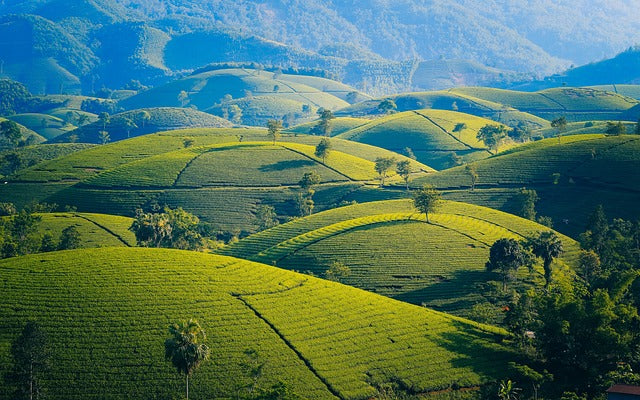
Your Guide to Tasting Terroir in Tea
Michele LillieWhat is Terroir?
Terroir is a concept very well-known in the wine world. As Merriam-Webster puts it, terroir is “the combination of factors including soil, climate, and sunlight that gives wine grapes their distinctive character.”
As Carl Hanson, a food and wine expert, explains, “It is terroir that gives value to a particular locality, setting it off from every other place and implying that a unique quality exists in that specific spot that cannot be reproduced anywhere else. Terroir is, in effect, the taste of the place.”
Since this is a Tea Blog, you might ask yourself, what does this have to do with tea? In reality, it has much to do with tea. Terroir is just as crucial in cultivating tea plants as grape vines. Imagine it as the “geographical signature” etched into every leaf, making each tea as unique as a fingerprint.
If you were to taste the many black teas offered at English Tealeaves, they would all taste different. This is, in great part, due to the concept of terroir. These teas are made from tea plants grown in seven countries. All have unique terroirs and the resulting tea tastes different.

We can also see this from teas grown in the same country but in various areas of that country. Drink a tea from the Darjeeling region of India and compare it to a tea grown in the Assam region of India. They will be very distinctive in appearance, aroma and flavor. Darjeeling teas will have strong muscatel notes and a flowery character. Assam teas have a bolder body with malty notes. Both are black teas but with very different flavors. Much of that is due to the difference in terroir.
The Soil Beneath
Soil composition plays a critical role in nourishing the tea plant. Different regions have unique soil types—some are rich in minerals, while others are acidic or alkaline. The roots then absorb these soil conditions and manifest themselves in the resulting tea leaves, affecting everything from aroma to mouthfeel. Nutrient-rich soil can produce teas with deep, robust flavors, whereas mineral-rich, rocky soil might produce teas with light, floral notes.
A Symphony of Climate and Elevation

Temperature, humidity, and rainfall are all part of a region's climate, and each element brings its own flair to the table. High-elevation teas often exhibit a bright and brisk profile, thanks to the cooler air and reduced rainfall. Lower elevations may yield a more robust and fuller-bodied experience. “High Mountain” teas are known for having a more complex flavor, less bitterness, and a creamier finish than teas grown at lower elevations.
Tea Processing – The Human Element
With tea, this concept of terroir extends beyond the growing phase. It continues with the harvesting and processing stage. (See our Tea Primer blog post for a more in-depth discussion of tea processing.)

Withering is a process that allows the tea leaves to lose some water content after picking. Teas that undergo minimal withering sustain very little water loss. This results in a more full-bodied and full-colored tea, although one-note in flavor. As the withering process is extended, the resulting teas have more complex flavors and aromas.
It is similar with oxidation. The rate and length of oxidation are critical as they determine the final briskness, strength, thickness, aroma and flavor of the cup of tea. Rapid oxidation results in darkly colored tea with abundant body, strength and briskness but very little complexity in the flavor. When oxidation proceeds at a slower rate, the chemical content of the leaves change, yielding teas that are more nuanced, mellow and complex.
Terroir and Your Tea Journey
Being mindful of terroir allows us to better match teas to our personal preferences or even to specific occasions. Whether you are looking for a light and floral oolong to compliment a summer afternoon or a hearty Assam to warm you in winter, understanding terroir equips you to make more informed and satisfying choices.
For the Novice Drinker
If you're just embarking on your tea journey, understanding terroir can be as simple as noticing the differences between teas from different regions. Try a green tea from China and another from Japan. You'll likely find that even though they are both green teas, their flavor profiles are worlds apart. Isn't it exciting to think that you're not just tasting tea but also capturing the essence of an entire region in your cup?
For the Seasoned Enthusiast

If you're a connoisseur, delving deep into terroir can offer an almost poetic experience. For you, it’s not just about recognizing differences; it’s about appreciating the harmony of factors that give each tea its identity. You may even find it rewarding to participate in vertical tastings—sampling different harvests from the same estate—to explore how a single terroir can produce variations in flavor from season to season.
In Conclusion
Embracing the concept of terroir is like receiving a personal invitation from each tea-growing region, urging you to explore and connect. It’s about respecting the diversity and uniqueness that each region brings into your cup and, in doing so, enriching your tea experience manifold. Stay tuned for more blog posts on the teas and terroir of specific countries.